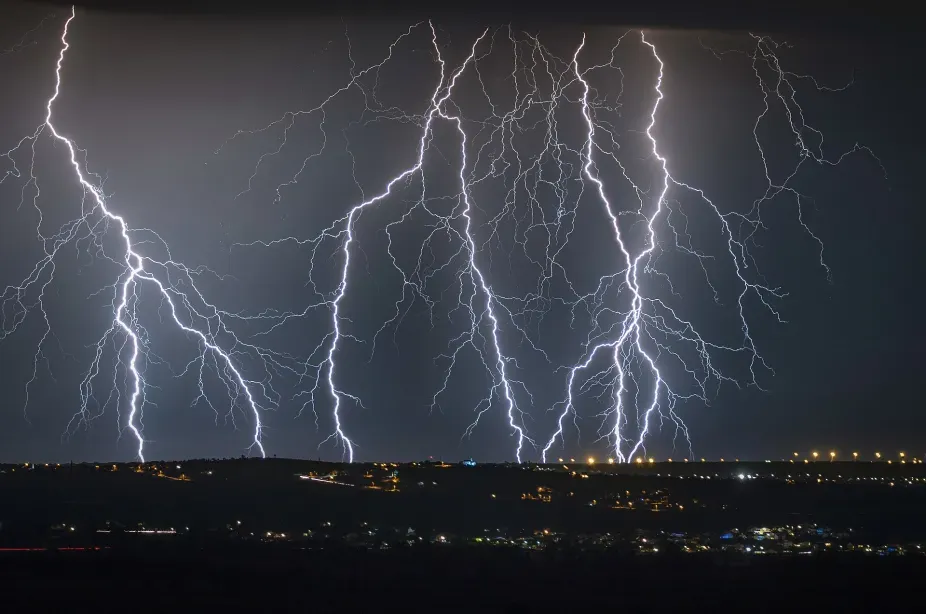The Science of Lightning and Thunder
Lightning and thunder are among nature’s most dramatic displays, captivating and terrifying in equal measure. These spectacular natural events are not just random occurrences but are deeply intertwined, driven by fascinating scientific principles. Let’s delve into the science behind lightning and thunder to understand how these awe-inspiring phenomena are created.
The Birth of Lightning
Lightning is a colossal discharge of electricity, a sudden spark that can illuminate the darkest storm clouds. But how does it form? It all begins with the buildup of electrical charges within a storm cloud. During a thunderstorm, strong currents of rising and descending air within the cloud cause collisions between tiny ice particles. These collisions generate electrical charges, with positive charges accumulating at the top of the cloud and negative charges gathering at the bottom.
When the difference in charge between the cloud and the ground (or within different parts of the cloud) becomes too great, the electrical potential breaks down the insulating properties of the air. This results in a rapid discharge of electricity we see as a lightning bolt. This discharge can occur within the cloud, between clouds, or from the cloud to the ground.
The Physics of a Lightning Strike
A lightning strike is incredibly fast and powerful. It can reach temperatures of about 30,000 Kelvin (53,540 degrees Fahrenheit), which is five times hotter than the surface of the sun. The intense heat causes the surrounding air to expand rapidly, creating a shock wave. This rapid expansion and subsequent contraction of air produce the sound wave we hear as thunder.
The entire process of a lightning strike is quick, often taking only a few milliseconds, yet it releases an immense amount of energy. A single bolt can carry up to a billion volts of electricity and can span several miles.
The Sound of Thunder
Thunder is the audible evidence of lightning, and it occurs because of the extreme heat generated by the lightning bolt. When the air is superheated to such high temperatures, it expands explosively. This expansion creates a shock wave that compresses the air, resulting in the booming sound of thunder. As the shock wave travels outward, it loses energy and eventually transforms into sound waves that we can hear.
Interestingly, the sound of thunder can vary. A close lightning strike will produce a sharp crack or loud bang, while a more distant strike will result in a rolling, rumbling sound. This variation occurs because sound waves bounce off objects like buildings, hills, and trees, creating echoes and reverberations.
Why We See Lightning Before Hearing Thunder
A common observation during thunderstorms is that we see lightning before we hear thunder. This discrepancy is due to the difference in the speed of light and the speed of sound. Light travels at an astonishing speed of approximately 300,000 kilometers per second (186,282 miles per second). In contrast, sound travels much slower, at about 343 meters per second (1,125 feet per second) in air.
Because light travels so much faster than sound, we see the flash of lightning almost instantaneously, while the sound of thunder reaches us with a delay. This delay can be used to estimate the distance of the lightning strike. By counting the seconds between the flash of lightning and the sound of thunder and then dividing by five, you can estimate how many miles away the lightning struck.
The Importance of Lightning and Thunder
Understanding the science behind lightning and thunder isn't just about appreciating a cool natural phenomenon. This knowledge is crucial for our safety. By knowing how lightning travels and the dangers it poses, we can take precautions during storms and avoid getting struck. Additionally, lightning helps us understand atmospheric processes better, leading to more accurate weather forecasting and early warnings for severe storms. Furthermore, lightning contributes to nitrogen fixation in the soil, a natural process that enriches soil fertility. Awareness of this phenomenon allows farmers to harness its benefits while mitigating its risks, ultimately leading to more sustainable and productive agricultural practices. So, the next time you see a lightning flash, remember—it's a reminder of both the power and the beauty of science at work.
Safety During Thunderstorms
Understanding the science behind lightning and thunder also highlights the importance of safety during thunderstorms. Lightning can strike from several miles away, even outside the rain area of the storm. It’s crucial to seek shelter in a sturdy building or a car, avoiding tall objects and open fields. If you’re caught outside, crouch down low on the balls of your feet, minimizing contact with the ground and reducing your risk of being struck.
Conclusion
Lightning and thunder are awe-inspiring phenomena that showcase the immense power and beauty of nature. By understanding the science behind these events, we can appreciate their complexity and take appropriate measures to stay safe. The next time you witness a lightning storm, you’ll know the intricate dance of electrical charges and shock waves that create one of nature’s most electrifying spectacles.




